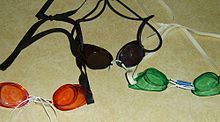Swimming goggles
A swimming goggles is a goggles that prevents water from reaching the eyes. This prevents eye irritation caused by chlorinated swimming pool water , for example . Seeing underwater is also more comfortable. It can be used for many water sports . It is only partially suitable for snorkeling .
history
The first written record comes from the 14th century, when Persian divers are said to have used glasses with tortoiseshell lenses. Such glasses can also be seen in a picture of Venetian coral divers from the 16th century. Most of the divers in the Middle Ages, however, were of African descent and did not use glasses. Divers from Polynesia used glasses made of bamboo or wood, later also glasses with glass lenses.
The first competitive swimmer to use glasses is said to have been Thomas Burgess, who was the first to swim the English Channel back and forth in 1911 . However, it was not waterproof, but only protected against waves and splashing water. When she crossed the canal in 1926, Gertrude Ederle used motorcycle goggles that had been waterproofed with paraffin . In 1916, CP Troppmann registered a patent for goggles for swimming underwater. In the 1930s, swimming goggles and diving masks were further developed, but they were not suitable for sports swimming. Another patent was filed by Walter Farrell in 1936. Channel swimmer Florence Chadwick used rubber twin-lens masks in the 1950s.
The first model for sport swimming was featured in an advertisement in Swimming World magazine in 1968 . The goggles were initially classified as training aids by the international swimming federation FINA and were not allowed in the competition. Even after their approval, they were initially only used by a few swimmers, as comfort and quality were insufficient. At the 1970 Commonwealth Games , Briton David Wilkie was believed to be the first to wear swimming goggles in an international competition.
The introduction of swimming goggles is considered to be one of the greatest technological advances in swimming . Until it was established in competitive sports, the swimmers' training scope was limited by the effects of chlorine and salt water on the eyes.
use
The advantage of swimming goggles is that when swimming you can exhale through your nose, which means that e.g. B. When swimming back, no water gets into the respiratory system (water would get into a diving mask when swimming due to the current). In addition, the resistance is lower than with a diving mask.
To put them on correctly, ensure that the glasses are placed around the eyes with both hands and then the headband is pulled over the back of the head. In the opposite case, the half-shells could snap back through the elastic band if they slip and possibly cause eye injuries. To remove it, you should therefore first pull the tape from the back to the front.
For shortsighted glasses wearers there are prefabricated swimming goggles in many dioptric strengths, which enable better orientation in the water.
Difference to the diving mask
It is important to distinguish the swimming goggles from the diving mask . The diving mask can be filled with air at any time under water through the nasal bay or this can escape. This prevents excessive pressure on the mask when descending and overpressure in the mask when ascending. This pressure equalization is not possible with swimming goggles, which is why they are used for swimming on the surface of the water and not for diving . Under no circumstances should you dive deeper than two meters with swimming goggles. The lack of pressure equalization otherwise creates a negative pressure inside the glasses, which can lead to ruptured blood vessels in the eyeball and even detachment of the retina ( barotrauma ).
treatment
Swimming goggles are very sensitive to mechanical stress and scratching and should therefore be kept in a hard case if possible. Cleaning should be done with clear, cold water . Swimming goggles are provided with an anti-fog coating on the inside by the manufacturer . This does not allow drying - not even with a microfiber cloth . Over time, the effect wears off, instead you can use special sprays or saliva .
Sweden glasses
A Sweden Glasses is a special swimming goggles, which especially in swimming is used and has a very low resistance in the water.
It consists of only two hard plastic shells connected with a rubber band and a plastic tube and is therefore very easy to adjust. The swimming goggles usually have to be assembled by yourself, but they are usually cheap to buy. Swedish glasses have a hard rim and no seal . Therefore it fits very well, but is not comfortable for everyone. Swedish glasses can often be seen at sporting competitions .
After a while in the water, the rubber band becomes porous and needs to be replaced.
Web links
Individual evidence
- ↑ a b The history of swimming goggles , translation of a text from ISHOF into German, blue-aqua-sports.com, accessed on November 22, 2016.
- ↑ Leaflet M3-001-06: Swimming and diving with swimming goggles (PDF; 73 kB) DLRG . Retrieved May 23, 2013.
- ↑ Fogging up? Clear vision in the swimming goggles Netzathleten-Magazin, February 25, 2013, accessed on May 5, 2016.

